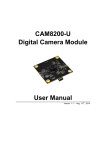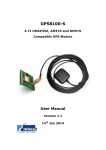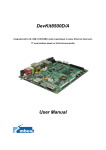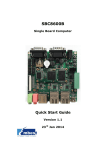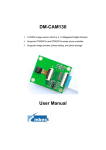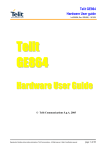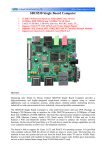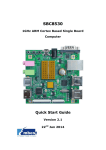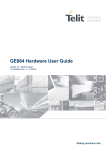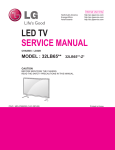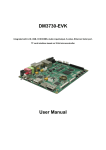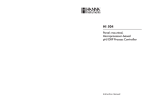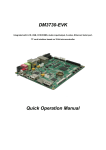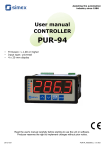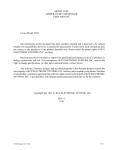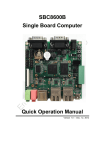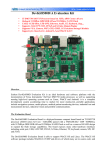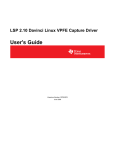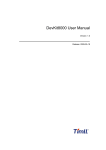Download CAM8000-D User Manual v2.1
Transcript
- CAM8000-D A 2 Megapixel CMOS Image Sensor (Digital Camera) for TI DM37x & AM37x User Manual Version 2.1 10th Jan 2014 Copyright Statement: CAM8000-D, SBC8530, SBC8100 Plus, DevKit8500 and their related intellectual property are owned by Shenzhen Embest Technology Co., Ltd. Shenzhen Embest Technology has the copyright of this document and reserves all rights. No part of the document should not be modified, distributed or duplicated in any approach and form without written permission issued by Embest Technology Co., Ltd. The use of Microsoft, MS-DOS, Windows, Windows95, Windows98, Windows2000 and Windows embedded CE 6.0 are authorized by Microsoft. Revision History: Version Date Description 1.0 20/06/2011 Original Version 2.0 16/09/2011 Added support for SBC8530 and SBC8510 2.1 09/01/2014 Localisation Table of Contents 1 Overview ........................................................................... 1 1.1 Product introduction .........................................................1 1.2 Kit Contents ....................................................................1 1.3 Board Interfaces ..............................................................2 1.4 Hardware Dimensions ......................................................2 2 Hardware Features ............................................................ 3 2.1 Technical Data ................................................................3 2.2 Supports ........................................................................3 2.3 Operational Parameters ....................................................3 3 Hardware Details ............................................................... 4 3.1 Interface Definitions ........................................................4 3.2 COMS interface (J1) .........................................................4 3.3 FPC interface (J2) ............................................................5 4 Steps for using Linux ......................................................... 7 4.1 Preparation .....................................................................7 4.1.1 Hardware: ................................................................................ 7 4.1.2 Software: ................................................................................. 7 4.2 Boot-up methods .............................................................7 4.3 Testing ...........................................................................8 4.3.1 LCD Display Test ....................................................................... 8 4.3.2 Photograph test ......................................................................... 8 4.4 Add the Driver to the Kernel .............................................9 5 Steps for using WinCE ..................................................... 10 5.1 Preparation ................................................................... 10 5.1.1 Hardware: .............................................................................. 10 5.1.2 Software: ............................................................................... 10 5.2 Boot-up methods ........................................................... 10 5.3 Testing ......................................................................... 11 5.4 Add the driver to NK.bin ................................................. 11 Appendix 1: ESD Precautions & Handling Procedures ......... 12 Appendix 2: Technical support & Warranty ........................ 13 2.1 Technical support service................................................ 13 2.2 Maintenance service clause ............................................. 14 2.3 Basic guidelines for protection and maintenance of LCDs .... 15 2.4 Value Added Services ..................................................... 16 1 Overview 1.1 Product introduction The CAM8000-D Digital Camera Module is designed to expand the functionality of several Embest boards. It can be used with the Dekit8500, SBC8100 Plus & SBC8530 evaluation boards. This module contains a CMOS camera; supporting image preview, photo taking and photo storage, in a small yet powerful package. The CAM8000-D is suitable for many applications such as: Portable Data Terminals Video Game Integration Home Automation CCTV Time Lapse Photography Web Streamed Video 1.2 Kit Contents CAM8000-D Module Page | 1 1.3 Board Interfaces Figure 1: CAM8000-D Interfaces 1.4 Hardware Dimensions Figure 2: CAM8000-D Hardware Dimensions Page | 2 2 Hardware Features 2.1 Technical Data Resolution: Up to 1600 x 1200 UXGA (Ultra Extended Graphics Array) Frame Rate: 15fps SVGA (Super Video Graphics Array) Frame Rate: 30fps Signal System: CMOS 2 MP Interface: 30-pin FPC connector 2.2 Supports Board support for: DevKit7000, DevKit8500, SBC8100 Plus & SBC8530 Resolution Support for: 640 x 480 & 1600 x 1200 2.3 Operational Parameters Working Temperature: -20°C ~ 70°C Dimensions: 38.11mm x 34.12mm x 6mm Power Supply: From board Page | 3 3 Hardware Details 3.1 Interface Definitions J1 J2 Figure 3: CAM8000-D Interfaces 3.2 COMS interface (J1) J1 Pin Signal Function 1 SIO_D SCCB input data 2 AVDD28 Power for analog voltage/sensor array(2.45V~3.0V) 3 SIO_C SCCB input clock 4 RESET Reset(active low with internal pull-up resistor) 5 VSYNC Vertical sync output 6 PWDN Power down(active low with internal pull-up resistor) 7 HREF Horizontal reference output 8 DVDD15 Power for digital core 9 DOVDD18 Power for I/O voltage (2.5V~3.30V) Page | 4 J1 Pin Signal Function 10 Y7 Digital video port(DVP) bit[7] 11 XCLK System input clock 12 Y6 Digital video port(DVP) bit[6] 13 DGND Ground for digital core 14 Y5 Digital video port(DVP) bit[5] 15 PCLK Pixel clock output 16 Y4 Digital video port(DVP) bit[4] 17 Y0 Digital video port(DVP) bit[0] 18 Y3 Digital video port(DVP) bit[3] 19 Y1 Digital video port(DVP) bit[1] 20 Y2 Digital video port(DVP) bit[2] 21 AGND Ground for analogue circuit 22 AGND Ground for analogue circuit 3.3 FPC interface (J2) J2 Pin Signal Function 1 GND GND 2 D0 Digital image data bit 0 3 D1 Digital image data bit 1 4 D2 Digital image data bit 2 5 D3 Digital image data bit 3 6 D4 Digital image data bit 4 7 D5 Digital image data bit 5 8 D6 Digital image data bit 6 Page | 5 J2 Pin Signal Function 9 D7 Digital image data bit 7 10 D8 Digital image data bit 8 11 D9 Digital image data bit 9 12 D10 Digital image data bit 10 13 D11 Digital image data bit 11 14 GND GND 15 PCLK Pixel clock 16 GND GND 17 HS Horizontal synchronization 18 VDD50 5V 19 VS Vertical synchronization 20 VDD33 3.3V 21 XCLKA Clock output a 22 XCLKB Clock output b 23 GND GND 24 FLD Field identification 25 WEN Write Enable 26 STROBE Flash strobe control signal 27 SDA IIC master serial clock 28 SCL IIC serial bidirectional data 29 GND GND 30 VDD18 1.8V Page | 6 4 Steps for using Linux 4.1 Preparation This chapter lists all the hardware and software needed to get the CAM8000-D up and running under a Linux Environment 4.1.1 Hardware: Target board (Including Devkit8500,SBC8100 Plus, SBC8530) CAM8000-D 7” LCD TF card 5V power adapter 4.1.2 Software: Linux image (Package-CAM8000-D\linux\image\) Testing tools (Package-CAM8000-D\linux\luvc_test) 4.2 Boot-up methods This Package provides images compatible with the target boards for starting a Linux system from a TF Card or NAND Flash allowing the user to test the CAM8000-D module. The default display mode is 4.3” LCD. Instructions for modifying the display modes are available within the user manuals for the respective boards. The default images provided with the target boards do not contain any drivers for the CAM8000-D. This document will not describe how to use an image to initialise the boards, for detailed information please refer to the relevant user manual. Page | 7 4.3 Testing Connect a 7” LCD and the CAM8000-D to the target board. Copy luvc_test (Package-CAM8000-D\linux\) to a TF card and insert the TF card into the board; boot the system, and then input the following commands: (This tutorial uses the Devkit8500 as an example) root@DevKit8500:~# insmod /usr/lib/ov2656.ko --------ov2656_probe --------ioctl_s_power 1 ------pidh= 0x26, pidl= 0x56 ov2656 2-0030: Detect success (26,56) --------ioctl_s_power 0 4.3.1 LCD Display Test cd /media/mmcblk0p1/ ./luvc_test -f yuyv -s 640x480 -S /dev/video0. // 640 * 480 resolution preview ./luvc_test -f yuyv -s 1600x1200 -S /dev/video0 // 1600 * 1200 resolution preview 4.3.2 Photograph test ./luvc_test -f yuyv -s 640x480 -c --skip 10 /dev/video0 // photographed as 640*480 resolution ./luvc_test -f yuyv -s 1600x1200 -c --skip 10 /dev/video0 //photographed as 1600*1200 resolution You will find the image saved as “capture.jpg” under /tmp. Note: skip 10 indicates the program will grab the picture after 10 frames, this number can be changed to anything the user requires Page | 8 4.4 Add the Driver to the Kernel The precompiled Linux images of the target boards do not contain a driver for the CAM8000-D, if you wish to add one, you will need to modify the kernel configuration by accessing the following menu: Add the ov2656 driver as module and deselect TVP514x driver, as the following picture shows: Exit and save, and then excute the following command to rebuild the kernel make uImage Page | 9 5 Steps for using WinCE 5.1 Preparation This chapter lists all the hardware and software needed to get the CAM8000-D up and running under a WinCE Environment 5.1.1 Hardware: Target board (Including Devkit8500,SBC8100 Plus, SBC8530) CAM8000-D 7” LCD TF card 5V power adapter 5.1.2 Software: WinCE image (Package-CAM8000-D\wince\target board\image) CameraDshowApp_digital.exe (Package-CAM8000-D\wince\target board\app) 5.2 Boot-up methods This Package provides images compatible with the target boards for starting a WinCE system from a TF Card or NAND Flash allowing the user to test the CAM8000-D module. The default display mode is 4.3” LCD. Instructions for modifying the display modes are available within the user manuals for the respective boards. The default images provided with the target boards do not contain any drivers for theCAM8000-D. This document will not describe how to use an image to initialise the boards, for detailed information please refer to the relevant user manual. Page | 10 5.3 Testing 1. Connect a 7” LCD and CAM8000-D to the target board, copy CameraDshowApp_digital.exe(Package-CAM8000-D\wince\app) to a TF card and insert the TF card into the board; boot the system, and then run CameraDshowApp_digital.exe from the TF card: Figure 4: CAM8000-D Capture Parameters 2. When the above window is displayed, click “OK”. You may need to wait a while as the program is relatively large and may take some time to open. 3. After the camera program is opened successfully, you can see images from the camera of the CAM8000-D module on the LCD screen. You can now use this program to carry out photo taking, image pickup; photo storage, and other operations. 5.4 Add the driver to NK.bin This process varies according to the board in use. Please read the relevant user manual for details. Page | 11 Appendix 1: ESD Precautions & Handling Procedures Please note that the board is supplied outside of an enclosure and some or all components are exposed. Therefore, extra attention must be paid to ESD (electrostatic discharge) precautions. To effectively prevent electrostatic damage, please follow the steps below: Avoid carpets in cool, dry areas. Leave development kits in their anti-static packaging until ready to be installed. Dissipate static electricity before handling any system components (development kits) by touching a grounded metal object. If possible, use antistatic devices, such as wrist straps and floor mats. Always hold an evaluation board by its edges. Avoid touching the contacts and components on the board. Take care when connecting or disconnecting cables. A damaged cable can cause a short in the electrical circuit. Prevent damage to the connectors by aligning connector pins before you connect the cable. Misaligned connector pins can cause damage to system components at power-on. When disconnecting a cable, always pull on the cable connector or strain-relief loop, not on the cable itself. Warning: This is a class A product. In a domestic environment this product may cause radio interference in which case the user may be required to take adequate measures. Page | 12 Appendix 2: Technical support & Warranty Embest Technology Co., Ltd. established in March of 2000, is a global provider of embedded hardware and software. Embest aims to help customers reduce time to market with improved quality by providing the most effective total solutions for the embedded industry. In the rapidly growing market of high end embedded systems, Embest provides comprehensive services to specify, develop and produce products and help customers to implement innovative technology and product features. Progressing from prototyping to the final product within a short time frame and thus shortening the time to market, and to achieve the lowest production costs possible. Embest insists on a simple business model: to offer customers high-performance, low-cost products with the best quality and service. 2.1 Technical support service Embest provides one year of free technical support for all products. The technical support service covers: Embest embedded platform products software/hardware materials Assistance to customers with regards to compiling and running the source code we offer. Troubleshooting problems occurring on embedded software/hardware platforms if users have followed the instructions provided. Judge whether a product failure exists. The situations listed below are not covered by our free technical support service, and Embest will handle the situation at our discretion: Customers encounter issues related to software or hardware during their development process Issues occur when users compile/run the embedded OS which has been modified by themselves. Page | 13 Customers encounter issues related to their own applications. Customers experience problems caused by unauthorised alteration of our software source code 2.2 Maintenance service clause 1. Product warranty will commence on the day of sale and last 12 months provided the product is used under normal conditions 2. The following situations are not covered by the warranty, Embest will charge service fees as appropriate: Customers fail to provide valid proof of purchase or the product identification tag is damaged, unreadable, altered or inconsistent with the product. Products are subject to damage caused by operations inconsistent with their specification; Products are subject to damage in either appearance or function due to natural disasters (flood, fire, earthquake, lightning strike or typhoon) or natural aging of components or other force majeure; Products are subject to damage in appearance or function due to power failure, external forces, water, animals or foreign materials; Products malfunction due to disassembly or alteration of components by customers, or repair by persons or organizations unauthorized by Embest Technology, or alteration from factory specifications, or configured or expanded with components that are not provided or recognized by Embest Technology; Product failures due to the software or systems installed by customers, inappropriate software settings or computer viruses; Products purchased from unauthorized merchants; Page | 14 Embest Technology takes no responsibility for fulfilling any warranty (verbal or written) that is not made by Embest Technology and not included in the scope of our warranty. 3. Within the period of warranty, the cost for sending products to Embest should be paid by the customer. The cost for returning the product to the customer will be paid by Embest. Any returns in either direction occurring after the warranty period has expired should be paid for by the customer. 4. Please contact technical support with any repair requests. Note: Embest Technology will not take any responsibility for products returned without the prior permission of the company. 2.3 Basic guidelines for protection and maintenance of LCDs 1. Do not use finger nails or other hard sharp objects to touch the surface of the LCD 2. Embest recommends purchasing specialist wipes to clean the LCD after long time use, avoid cleaning the surface with fingers or hands as this may leave fingerprints or smudges. 3. Do not clean the surface of the screen with unsuitable chemicals Note: Embest do not supply a maintenance service for LCDs. We suggest the customer immediately checks the LCD once in receipt of the goods. In the event that the LCD does not run or shows no display, the customer should inform Embest within 7 business days of delivery. Page | 15 2.4 Value Added Services We will provide following value added services: Driver development based on Embest embedded platforms for devices such as: serial ports, USB interface devices, and LCD screens. Control system transplantation, BSP driver development, API software development. Other value added services including supply of power adapters and LCD parts. Other OEM/ODM services. Technical training. Please contact Embest with any technical support queries: http://www.embest-tech.com/contact-us.html Page | 16




















